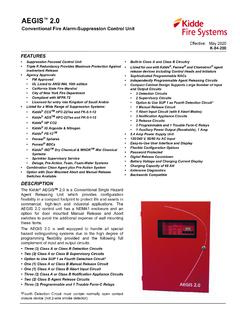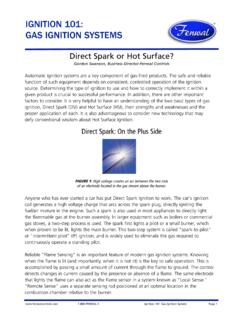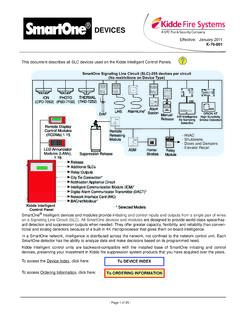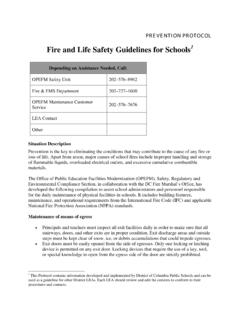Transcription of Kidde Clean Agent Fire Extinguishing System FM-200®
1 Kidde Clean Agent fire Extinguishing System Employing Chemours FM-200 . 1. GENERAL. INTENT OF SPECIFICATIONS. This specification outlines the requirements for a total flooding Clean Agent fire Extinguishing System comprising Kidde fire Systems equipment employing Chemours FM-200 waterless fire suppressant propelled by 1800-psig Nitrogen. All requirements outlined in this specification must be completed in their entirety. These requirements, which are in accordance with the items listed in Section , combined with good engineering practices shall be followed in order to produce a safe and effective Clean Agent fire Extinguishing System . GENERAL DESCRIPTION. The Clean Agent fire Extinguishing System shall perform as outlined in the following sub-sections. A. Achieve a (v/v) Extinguishing concentration for Class A (Surface Type Fires) hazards. B. Achieve a (v/v) or greater, as required, Extinguishing concentration for Class B. (Flammable Liquids) hazards. C. Achieve a (v/v) Extinguishing concentration for Class C (Energized Electrical Equipment) hazards.
2 D. Within 10 seconds, the Clean Agent fire Extinguishing System shall discharge 95% of the required suppression Agent mass. E. The Clean Agent fire Extinguishing System shall consist of one or more Kidde fire Systems Agent cylinders and related equipment. The cylinders may be either connected to a discharge pipe arrangement separately or connected to a common manifold and discharge pipe arrangement. The Agent cylinders shall be filled with FM-200 only. Each Agent cylinder will have a complement of seamless cylinder(s) storing dry nitrogen at 1800 PSIG at 70 F ( bar gauge at 21 C). F. The System shall comply with the new requirement of NFPA to supervise the placement of electrical control head on the cylinder valve. Removal of the electrical actuator shall register a supervisory trouble in the fire alarm control panel through audio and visual indication. G. Should there be any selector valves in the System , the solenoid of the selector valve shall be supervised for its placement.
3 Removal of the electrical solenoid shall register a supervisory trouble in the fire alarm control panel through audio and visual indication. CODES AND COMPLIANCE. A. The design, installation, testing and maintenance of the Clean Agent fire Extinguishing System , shall be in accordance with the following codes, standards and regulatory bodies: 1. NFPA 2001: Standard for Clean Agent fire Extinguishing Systems 2. UL1266: Standard for Halocarbon Clean Agent Extinguishing System Units 3. ANSI : Standard for pipe threads, General Purpose 4. NFPA 70: National Electrical Code (NEC). 5. NFPA 72: National fire Alarm Code 6. Factory Mutual Approval Guide 7. Requirements of the Local Authorities Having Jurisdiction (AHJ). 8. Kidde fire Systems Manual P/N 90-FM200M-030. B. The complete System shall have the applicable following listings and approvals: 1. Underwriters Laboratories (UL). 2. Factory Mutual Global (FM). 3. Underwriters Laboratories of Canada (ULC). C. The manufacturer shall meet ISO 9001 requirements for the design, production and distribution of the FM-200 fire suppression System .
4 December 2015 Page 1 of 6. Kidde Clean Agent fire Extinguishing System Employing Chemours FM-200 . D. All components of the Clean Agent fire Extinguishing System shall be the products of the same manufacturer or listed by that manufacturer as compatible with those devices, components and equipment. System DESIGN CRITERIA. A. A total flooding Clean Agent fire Extinguishing System , employing FM-200, shall be installed to meet a minimum design concentration of _____% by volume in all designated spaces to be protected. QUALIFICATIONS. A. Manufacturer 1. The manufacturer/supplier of the System hardware and components shall have a minimum of fifteen (15) years experience in the design and manufacture of systems of similar type 2. The manufacturer/supplier of the systems shall be certified to ISO 9001 for a minimum period of five (5) years for the design, production and distribution of fire detection, fire alarm and fire suppression systems. 3. The name of the manufacturer/supplier and manufacturer part numbers shall appear on all major components.
5 4. All devices, components and equipment shall be the products of the same manufacturer/supplier. 5. The System manufacturer/supplier shall have the ability to provide multiple suppression System arrangements to accommodate the performance criteria required by the project. 6. All devices, components and equipment shall be listed by the standardizing agencies (UL. and/or FM). B. Contractor 1. The distributor shall be trained by the manufacturer to calculate/design, install, test and maintain the Clean Agent fire Extinguishing System employing FM-200 and shall be able to produce a certificate stating such on request. 2. The installing contractor shall employ a person who can show proficiency at least equal to a NICET level III certification in special hazards design. 3. The Contractor shall confirm in writing that he stocks a full complement of spare parts and offers 24-hour emergency service for all equipment being furnished. WARRANTY. A. Components provided by the manufacturer shall carry a warranty of thirty-six (36) months from date of shipment or one (1) full year from the date of installation.
6 SUBMITTALS. A. The architect will review all submittals for conformance to the drawings and specifications. The contractor shall be required to resubmit any materials, with appropriate modifications, that are found to be in non-conformance with the requirements of the drawings and these specifications after review by the architect. Approval of the submittals by the architect shall not relieve the Contractor of their responsibility to meet the requirements of the drawings and specifications. B. Engineered Design Drawings: The Contractor shall provide all required documents that shall include the following details: 1. The factory-authorized Kidde fire Systems Distributor shall provide all required installation drawings per NFPA 2001. C. Flow Calculation Reports 1. The distributor shall provide the following information in the flow calculation report. i. Customer information and project data December 2015 Page 2 of 6. Kidde Clean Agent fire Extinguishing System Employing Chemours FM-200.
7 Ii. Hazard information. At a minimum, hazard information shall include the minimum design concentration and adjusted design concentration, minimum and maximum enclosure ambient temperature, minimum Agent required, volume of enclosures and any corresponding non-permeable volume, and identify the quantity of discharge nozzles. iii. Cylinder information. At a minimum, cylinder information shall include total Agent required, cylinder capacity, cylinder part number, cylinder quantities (both main and reserve), Agent fill amount per cylinder and floor loading per cylinder. iv. Pipe network information. At a minimum, pipe network information shall include pipe type, pipe diameter, pipe length, change in elevation, pipe equivalent length and any added accessory equivalent length. In addition, the following nozzle information shall be provided; number of nozzles and identification of enclosure location, flow rate of associated nozzle, nozzle nominal pipe size, nozzle type and nozzle orifice area.
8 V. Pipes and pipe fittings. A detailed list of pipe, by schedule, nominal diameter and length, and fittings, by nominal diameter and quantity. D. OPTIONAL: Three-Way Ball Valve Information. A calculation shall be completed for each directional valve in the piping network. Modeling of the Three-Way Ball Valve shall be shown in the open and closed position E. Commissioning Equipment List: The distributor shall provide a commissioning equipment list for each installed Clean Agent fire Extinguishing System . The equipment list shall identify all installed equipment and configurations. F. Test Plan 1. The distributor shall submit a test plan that describes how the System equipment and room integrity shall be tested. This shall include a step-by-step description of all tests and shall indicate type and location of test apparatus to be used. At a minimum, the tests to be conducted shall be per NFPA 2001 and any additional supplemental tests required by the AHJ. Tests shall not be scheduled nor conducted until the engineer of record approves the test plan.
9 G. Installation Drawings 1. Four (4) sets of installation drawings for each installed Clean Agent fire Extinguishing System and one (1) set of the calculation report, owner's manual and product data sheets shall be submitted to the end-user/owner. 2. Upon completion of installation and commissioning acceptance, two (2) sets of As-Built . installation drawings and One (1) set of the calculation report for each installed Clean Agent fire Extinguishing System shall be given to the owner/end-user for use and reference. H. Operation and Maintenance Manuals 1. Two (2) copies of the Kidde fire Systems Design, Installation, Operation and Maintenance Manual for the Clean Agent fire Extinguishing System employing FM-200. shall be submitted after complete installation. 2. suppression System REQUIREMENTS. GENERAL. A. The Clean Agent fire Extinguishing System shall consist of FM-200, Agent cylinder(s), 1800- psig seamless nitrogen cylinders, Kidde actuation hardware and Kidde discharge nozzle(s).
10 Attached to a pipe network. System PERFORMANCE. A. System Discharge 1. The discharge time required to achieve 95% of the minimum design concentration for flame extinguishment shall not exceed 10 seconds. B. Duration of Protection December 2015 Page 3 of 6. Kidde Clean Agent fire Extinguishing System Employing Chemours FM-200 . 1. 85% of the minimum design concentration shall be maintained for 10-minutes or a sufficiently longer period of time to allow effective emergency action by trained personnel. A level 1 certification in room integrity testing, provided by a recognized manufacturer of room integrity testing equipment, is required. C. Minimum System Design Limits 1. Nozzles i. Nozzles shall be listed and approved for a maximum ceiling height of 16 feet ( m) and a minimum ceiling height of 1 foot ( m). ii. Nozzle area coverage for both 360- and 180-degree nozzles shall be a maximum of 46-ft x 56-ft ( x ). iii. System Nozzles shall be listed and approved for a minimum of 72 PSIG ( bar gauge) nozzle pressure.











